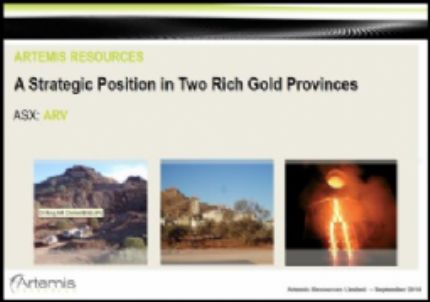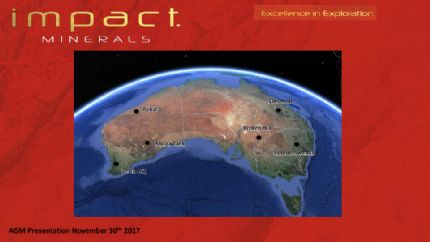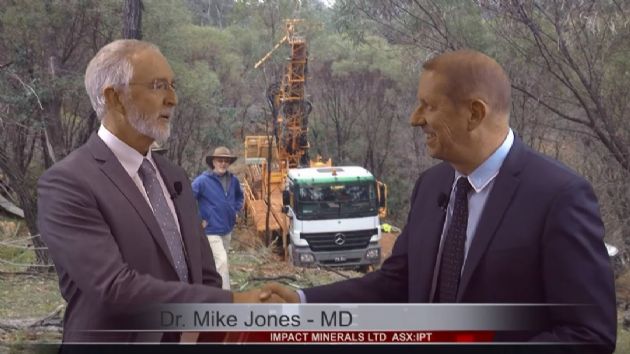 Gold Bearing Conglomerates Identified by Previous Explorers
Gold Bearing Conglomerates Identified by Previous Explorers
Perth, Nov 27, 2017 AEST (ABN Newswire) - Earlier this year Impact Minerals Limited ( ASX:IPT) applied for nine new 100% owned Exploration Licences covering 1,300 sq km of ground prospective for conglomerate-hosted gold in the Pilbara region of Western Australia (see Figure 1 in link below).
ASX:IPT) applied for nine new 100% owned Exploration Licences covering 1,300 sq km of ground prospective for conglomerate-hosted gold in the Pilbara region of Western Australia (see Figure 1 in link below).
This followed a review of the discovery of gold in conglomerates at the base of the Fortescue Group by Artemis Resources Limited ( ASX:ARV) and the subsequent joint venture with Novo Resources Corporation.
ASX:ARV) and the subsequent joint venture with Novo Resources Corporation.
- A review of previous exploration data and field checking indicates at least 90 kilometers of prospective Fortescue Group conglomerates occur at or near-surface on Impact's licence applications which cover 1,300 sq km in the Pilbara region Western Australia
- Rock chip results of up to 11.2 g/t gold occur at the Glen Herring Prospect 10 km west of Marble Bar in a gold-pyrite conglomerate that extends for 25 kilometres.
- A single diamond hole at Shady Camp Well returned 0.9 metres at 0.6 g/t gold that has not been followed up.
- Other gold-bearing conglomerates identified on or adjacent to Impact's licences.
- The conglomerates on Impact's licences are similar to those that occur in the Witwatersrand Basin of South Africa where the majority of the gold-bearing reefs are only 1 to 2 metres wide and easily missed.
- A recent field visit to the Purdeys Reward-Comet Well area with Novo-Artemis has highlighted the different types of conglomerate-hosted gold in the Pilbara as well as the challenges in exploring for such deposits.
- Impact is conducting on-ground reconnaissance exploration to ascertain access conditions and to determine the best sampling approach for gold both in nugget form as well as finely disseminated gold, both of which occur in the East Pilbara.
This discovery indicated a significant breakthrough had been made in the search for conglomerate hosted gold deposits of a similar age to the Witwatersrand Basin of South Africa in the Pilbara and Impact was an early mover in applying for available ground considered prospective for this style of deposit (see announcement dated 28th September 2017).
Impact is completing a review and synthesis of previous exploration data and mapping by the Geological Survey of Western Australia (GSWA) with particular focus on the two most prospective conglomerate horizons within the Fortescue Group:
1. Conglomerates of the Hardey Formation. These rocks host the Beatons Creek resource (6.4 Mt at 2.7 g/t gold for 558,000 ounces of gold) held by Novo Resources Corporation near Nullagine (see Figure 1 in link below); and
2. Conglomerates at the base of the Mt Roe Basalt. The recent gold discovery at Purdeys Reward-Comet Well by Novo Resources and Artemis Resources Limited occurs within this unit (see Figure 1 in link below).
Field checking and previous mapping indicates that the prospective conglomerates occur over at least 90 kilometres of trend at or close to surface within Impact's licence applications, in particular to the west and east of Marble Bar as well as close to the Beatons Creek deposit near Nullagine.
West of Marble Bar, previous exploration in the district highlights several gold occurrences associated with the conglomerate horizons on and along trend from Impact's licence applications ELA45/4972 and ELA45/4971 (see Figure 2 in link below).
Here, four main gold-bearing conglomerate occurrences with similar characteristics to those that occur within the Witwatersrand Basin have been discovered:
1. At the Glen Herring Prospect previous rock chip samples in 1989 returned assays of up to 11.2 g/t gold from a gold-pyrite bearing conglomerate within the Hardey Formation which extends for 10 km of strike on Impact's licence ELA44/4972 (see Figure 2 in link below).
2. At the Shady Camp Well Prospect one diamond drillhole was completed by Western Mining Corporation in 1976 to test a surface gold and uranium anomaly in conglomerate-sandstone and returned 0.9 metres at 0.6 g/t gold from 174 metres downhole in quartz pebble conglomerate with rounded pyrite in the matrix. The conglomerate occurs close to a carbonaceous shale unit. Assays of up to 320 ppm uranium were also returned in places. Carbon and uranium are signficant accessory minerals in the Witwatersrand Basin and Impact considers these results to be significant. Further gold and uranium-bearing conglomerates in the Hardey Formation have been identified by previous explorers for at least 10 km along strike from Shady Camp Well.
The same conglomerates also extend for a further 15 km along strike to the southwest outside of Impact's licence where historic assays returned up to 2.1 g/t gold and 45 ppm uranium (see Figure 2 in link below).
3. Gold-bearing pyritic quartz pebble conglomerates have been identified at the base of the Mt Roe Formation by several previous explorers at the Contact Creek Prospect which lies 6 km west of Impact's licence E45/4971 with the the best rock sample result of 15.9 g/t gold by Novo Resources in 2013 (see Figure 2 in link below). This gold-bearing conglomerate extends to the east and occurs very close to surface over at least 4 km of strike on Impact's licence ELA45/4971.
4. The Hardey Formation sandstones and conglomerates have been mapped by the GSWA over at least 25 km of strike on ELA45/4971 and rock samples of conglomerate with very strong pyrite returned up to 0.26 g/t gold by CRA Exploration in 1987 (see Figure 2 in link below).
The chemistry and characteristics of the conglomerates from the four propsect areas are similar to those observed in Witwatersrand-style conglomerate-hosted gold deposits. These characteristics include:
- Widespread gold-bearing conglomerates with highly elevated uranium in places;
- The identification of rounded detrital pyrite within the matrix between conglomerate clasts; and
- The occurrence of black carbonaceous shale that occurs in close proximity to the conglomerates
These are significant observations and are very encouraging for further exploration on Impact's 100% owned Pilbara Gold Project.
Impact's Managing Director Dr Mike Jones said: "We were recently priviliged to visit the Purdeys Reward-Comet Well area with Novo Artemis and have seen first hand the reasons why it had not been discovered before, the potential scale of the discovery and also the difficulties of exploring and sampling for this style of deposit. It is evident that there is a wide range in size and distribution of gold within these conglomerates and it is this that has hampered previous exploration for this style of mineralisation.We are now determining the most appropriate sampling methodologies for our on-ground exploration which will commence in earnest on grant of the licences.
To view figures, please visit:
http://abnnewswire.net/lnk/77P13Z2Y
About Impact Minerals Limited
 Impact Minerals Limited (ASX:IPT) is an exploration company listed on the ASX in November 2006. The Company manages extensive tenement holdings (>2,000 km2) within Australia featuring significant potential for high-grade mineral deposits of gold, silver, lead, zinc, copper, nickel and PGM's. The Directors of the Company have extensive experience in mineral exploration and a strong history of exploration success, business development and corporate management. Impact Minerals intends to build wealth for its shareholders through a vigorous campaign of project generation and evaluation with a view towards profitable mining operations.
Impact Minerals Limited (ASX:IPT) is an exploration company listed on the ASX in November 2006. The Company manages extensive tenement holdings (>2,000 km2) within Australia featuring significant potential for high-grade mineral deposits of gold, silver, lead, zinc, copper, nickel and PGM's. The Directors of the Company have extensive experience in mineral exploration and a strong history of exploration success, business development and corporate management. Impact Minerals intends to build wealth for its shareholders through a vigorous campaign of project generation and evaluation with a view towards profitable mining operations.
![abnnewswire.com]()
Related Companies
Social Media
Share this Article

 ASX:IPT) applied for nine new 100% owned Exploration Licences covering 1,300 sq km of ground prospective for conglomerate-hosted gold in the Pilbara region of Western Australia (see Figure 1 in link below).
ASX:IPT) applied for nine new 100% owned Exploration Licences covering 1,300 sq km of ground prospective for conglomerate-hosted gold in the Pilbara region of Western Australia (see Figure 1 in link below).  ASX:ARV) and the subsequent joint venture with Novo Resources Corporation.
ASX:ARV) and the subsequent joint venture with Novo Resources Corporation.  Impact Minerals Limited (ASX:IPT) is an exploration company listed on the ASX in November 2006. The Company manages extensive tenement holdings (>2,000 km2) within Australia featuring significant potential for high-grade mineral deposits of gold, silver, lead, zinc, copper, nickel and PGM's. The Directors of the Company have extensive experience in mineral exploration and a strong history of exploration success, business development and corporate management. Impact Minerals intends to build wealth for its shareholders through a vigorous campaign of project generation and evaluation with a view towards profitable mining operations.
Impact Minerals Limited (ASX:IPT) is an exploration company listed on the ASX in November 2006. The Company manages extensive tenement holdings (>2,000 km2) within Australia featuring significant potential for high-grade mineral deposits of gold, silver, lead, zinc, copper, nickel and PGM's. The Directors of the Company have extensive experience in mineral exploration and a strong history of exploration success, business development and corporate management. Impact Minerals intends to build wealth for its shareholders through a vigorous campaign of project generation and evaluation with a view towards profitable mining operations.














